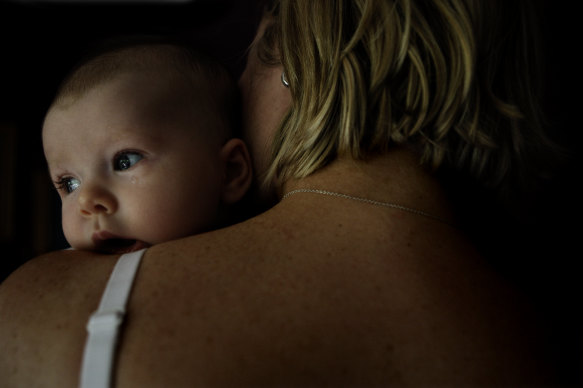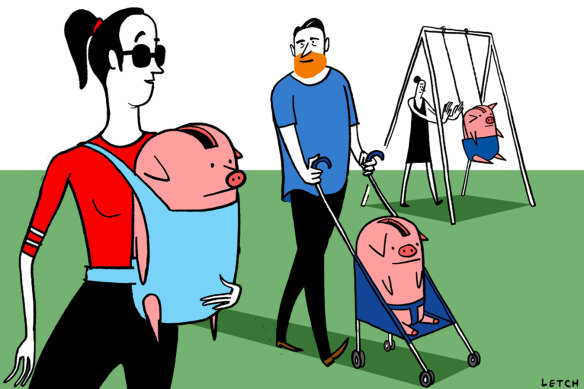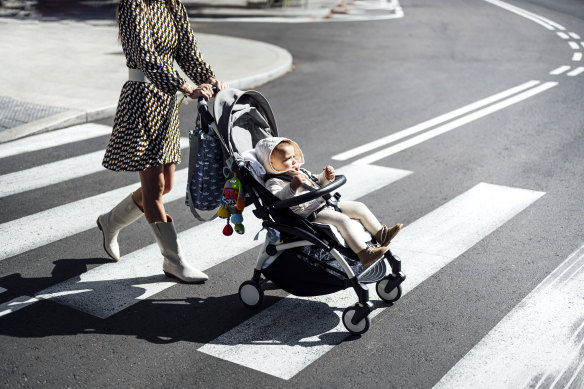
Australia’s baby drought underscores challenges facing young workers
July 4, 2023Save articles for later
Add articles to your saved list and come back to them any time.
Where have all the babies gone? Australia’s fertility rate is near historic lows and there are signs it will fall further.
The baby drought is most noticeable in our biggest cities. In the Melbourne City statistical region the fertility rate slumped to 0.66 in 2021 – a fraction of the 2.1 “replacement level” rate needed for a stable population, not including migration.
A decline in the fertility rate highlights challenges facing young workers.Credit: Louise Kennerley
In Sydney, mothers under 35 years are increasingly rare – the 2021 census revealed nearly half the city’s women aged 30 to 34 have never had a child.
The national fertility rate, which measures the average number of children a woman can be expected to have during her reproductive lifetime, hit rock bottom in 2020 amid the disruption and uncertainty of the COVID-19 crisis. There was a modest recovery in 2021 but the cost-of-living crunch caused by high inflation and rising interest rates, which has now dragged on for more than a year, threatens to snuff that out.
During the first three months of 2023 the number of births in public maternity wards in NSW was the lowest of any quarter since records began 13 years ago.
An array of personal factors has always affected decisions about childbearing including education, career and financial circumstances. Economic conditions, especially labour market stability, play a role as do social norms and expectations.
Credit: Simon Letch
But the recent decline in the fertility rate is also a bellwether of unique contemporary challenges facing young workers: high housing costs, falling real wages, insecure work and student debt have all made the decision to have kids more challenging.
KPMG urban economist Terry Rawnsley says there is a clear link between housing affordability and fertility rates.
“When you compare Sydney, Melbourne, Brisbane and Perth, it is the cheaper-to-live-in cities that tend to have higher fertility rates because it’s a much easier equation to have more children,” he says.
A new study of workers under the age of 40 by Sydney University’s Gender Equality in Working Life Research Initiative found 70 per cent of the women surveyed reported the cost of housing influences the number of children they plan to have.
The cost of housing is a consideration for many young people in deciding to have children.Credit: Dion Georgopoulos
A separate 2022 survey by the Australian National University found being able to buy a home, or a better home, was “extremely important” for people when thinking about future childbearing plans, especially for younger respondents and those with lower levels of education.
But housing is not the only consideration. Access to secure work and affordable childcare also have a major influence on childbearing decisions, especially for women.
The threat posed by climate change is another factor, especially for those aged under-30. The Sydney University study found 43 per cent of 18-30 year olds said climate change has a “great deal” or “fair amount” of influence on how many children they plan to have. Among 31-40 year olds the share was 31 per cent (the share of men and women with this concern was roughly equal).
A few years back the federal government predicted Australia would have a long-term fertility rate of 1.9 babies per woman, only a little below the replacement level of 2.1. But that forecast has since been slashed to 1.62.
Flinders University population expert Udoy Saikia says even that lower forecast may prove optimistic.
“Over the next 20 to 30 years I wouldn’t be surprised if the fertility rate goes down to 1.4 or even 1.3, that’s what’s happening in European countries,” he says.
Australia’s baby drought is part of a global trend. Fertility rates have fallen below 1.5 across much of Europe and East Asia. Japan’s population has been declining for more than a decade due to low fertility combined with low overseas migration. In South Korea the fertility rate fell to just 0.78 in 2022, the lowest among wealthy country members of the Organisation for Economic Cooperation and Development.
Robust migration levels mean Australia’s population is forecast to grow steadily over the next 40 years.
A fertility rate slump will have lasting economic consequences.Credit: Getty
Even so, a fertility rate slump will have lasting economic consequences. The most obvious is a lower ratio of young workers to pensioners – that will heap pressure on the capacity of governments to deliver welfare and health services. A special report in The Economist recently pointed out that older populations tend to be less enterprising and more risk averse – this threatens to hinder innovation and productivity growth.
People generally express a wish to have more children than they end up with. A recent study found that Australians want two children, on average.
That suggests many are settling for fewer children than they would otherwise like. Researchers say a growing share of young workers, especially women, report they do not intend to have any children. Many cite the motherhood penalty – the lifetime loss of earnings typically experienced by women with children – as a reason for this choice. Others just want to make the most of the investments they’ve made in education.
In recent decades governments have devoted additional resources to assist working families including paid parental leave and childcare subsidies. But much more radical measures to support parents will be needed to prevent further declines in the fertility rate.
That might seem an obvious policy response given the long-term economic benefits of a higher birth rate. But as Australia’s population ages, and the grey vote grows, the demands of older people will be difficult for politicians to resist. The politics of fertility and family formation is set to become increasingly tricky.
Matt Wade is a senior economics writer.
The Opinion newsletter is a weekly wrap of views that will challenge, champion and inform your own. Sign up here.
Most Viewed in Business
From our partners
Source: Read Full Article






